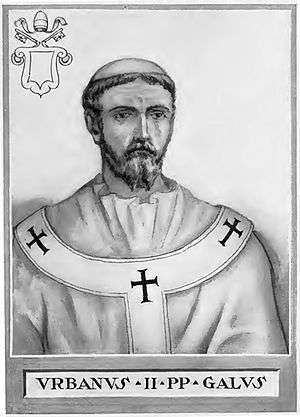1088 papal election
A papal election subsequent to the death of Pope Victor III in 1087 was held on 12 March 1088. Six cardinal-bishops, assisted by two lower-ranking cardinals, elected Cardinal-Bishop of Ostia Odon de Lagery as the new Pope. He assumed the name Urban II.
| Papal election 1088 | |
|---|---|
| Dates and location | |
| 12 March 1088 Terracina | |
| Elected pope | |
| Odon de Lagery Name taken: Urban II | |
 | |
Background
Pope Victor III died on 16 September 1087 at Montecassino. Shortly before his death he recommended the election of Cardinal Odon de Lagery as his successor. Rome at that time was under control of Antipope Clement III, who was supported by the Emperor Henry IV of Germany, and there was no hope for its quick recovery. In this situation the adherents of Victor III assembled on 9 March 1088 at Terracina, under the protection of the Norman army, to elect the new Pope. Besides Cardinal-Bishops, who were the sole electors of the Pope, at the electoral assembly in the episcopal church of SS. Pietro e Cesareo there were present also the representatives of the two lower orders of cardinals, over 40 bishops and abbots, as well as Benedetto, prefect of Rome and Countess Matilda of Tuscany.
The usual three days of fasting and prayer were proclaimed, and the meeting adjourned until Sunday 12 March. On that day the cardinals and the rest of the present churchmen and laymen reassembled in the same church. The Cardinal-Bishops of Albano, Tusculum and Porto together proposed the election of Odon de Lagery, Cardinal-Bishop of Ostia, who had been designated by Victor III. He accepted his election and took the name Urban II. The election was publicly announced by Cardinal Peter Igneus of Albano. On the same day, the new Pope was enthroned and celebrated the inauguration mass.[1] However, it was not until November 1088 that Urban II was able to travel to Rome.[2]
Cardinal-electors
According to the decree of Nicholas II In Nomine Domini (1059) Cardinal-Bishops of the suburbicarian sees were the sole electors of the Pope. In March 1088 there were six Cardinal Bishops:[3]
| Elector | Cardinalatial title | Elevated | Elevator | Notes |
|---|---|---|---|---|
| Ubaldo | Bishop of Sabina | 1063 | Alexander II | |
| Giovanni Minuto | Bishop of Tusculum | 1066 | Alexander II | Created as cardinal-priest of S. Maria in Trastevere, promotion to the suburbicarian see probably in 1073 |
| Peter Igneus, O.S.B.Vallombrose | Bishop of Albano | 1072 | Alexander II | He announced the election of Urban II |
| Odon de Lagery, O.S.B.Cluny | Bishop of Ostia | 1080 | Gregory VII | Elected Pope Urban II |
| Giovanni | Bishop of Porto | 1085 or 1087 | Gregory VII or Victor III | |
| Bruno | Bishop of Segni | 1079 | Gregory VII | Chancellor of the Holy Roman Church |
Assistant electors
Two Cardinals of the lower ranges, one Cardinal-Priest and one Cardinal Deacon assisted at the election:[4]
| Elector | Cardinalatial title | Elevated | Elevator | Notes |
|---|---|---|---|---|
| Rainiero, O.S.B. | Priest of S. Clemente | 1078 | Gregory VII | Abbot of the monastery of S. Lorenzo fuori le mura; future Pope Paschal II (1099-1118) |
| Oderisio de Marsi, O.S.B.Cas. | Deacon of the Sacred Lateran Palace (deaconry unknown[5]) | 1059 | Nicholas II | Abbot of Montecassino |
Notes
- Miranda, Salvador. "Election of March 12, 1088 (Urban II)". The Cardinals of the Holy Roman Church. Florida International University.
- The Catholic Encyclopedia: Pope Urban II
- I.S. Robinson, p. 62; Klewitz, p. 39; Salvador Miranda, papal election of 1088
- H.W. Klewitz, p. 88; I.S.Robinson, p. 62; Salvador Miranda, papal election of 1088
- Klewitz, p. 91 suggests that he may have been predecessor of Giovanni Coniulo (future Pope Gelasius II) as cardinal-deacon of S. Maria in Cosmedin, but this is not attested in the documents. Salvador Miranda says that he was deacon of S. Agata, but it seems to be confusion with Oderisio de Sangro.
Bibliography
- I. S. Robinson, The Papacy, 1073-1198: Continuity and Innovation, Cambridge University Press, 1990
- H.W. Klewitz, Reformpapsttum und Kardinalskolleg, Darmstadt 1957